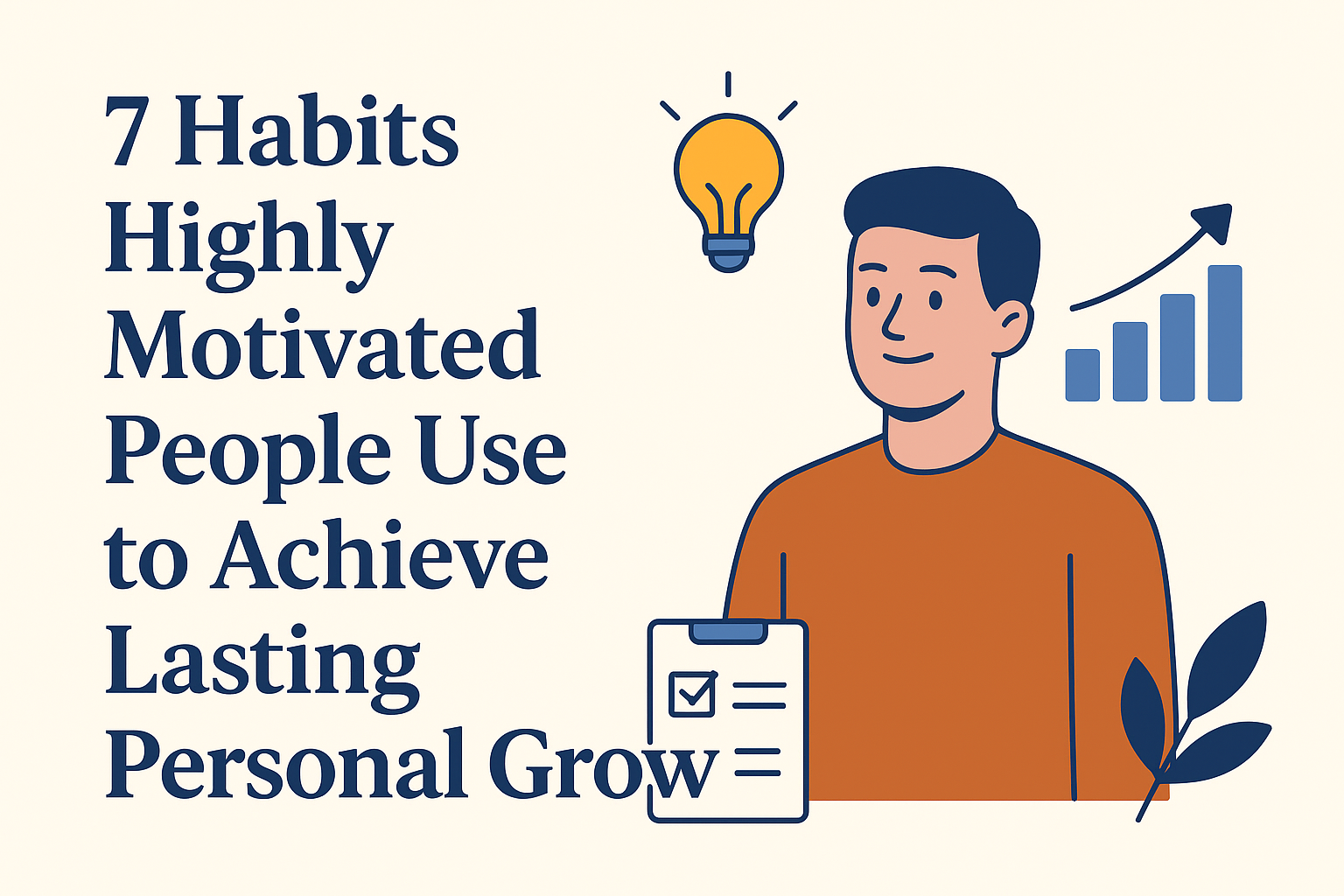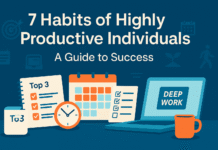Motivation is not a one-time spark — it’s a set of habits you cultivate, refine, and protect. In this guide you’ll discover the 7 habits highly motivated people use repeatedly to move from intention to consistent progress on their personal growth journeys. Whether you’re recharging after a setback, beginning a new chapter, or trying to turn good intentions into reliable outcomes, this article gives practical, step-by-step methods you can apply immediately.
Who this article is for: readers who want structure and tools (not platitudes) for lasting motivation — beginners and intermediate self-developers, professionals balancing growth with work life, and anyone who wants a clear roadmap for turning aspirations into habits.
What you’ll learn: what each habit is, why it matters, exactly how to implement it (beginner-friendly steps), low-cost/no-cost alternatives, how to scale it, common pitfalls, measurement ideas, and a short sample mini-plan you can try right away.
Key takeaways
- Motivation is a set of repeatable habits you can design; the environment, clarity of goals, and small wins matter more than willpower alone.
- Specific, measurable goals combined with small, consistent daily actions are more sustainable than vague ambitions.
- Energy and social support are as important as strategy — rest, nutrition, and accountability amplify effort.
- Reflection and adaptation turn experience into momentum: track, review, tweak, and repeat.
- Start tiny, build consistency, then scale — the simplest changes are often the most durable.
Habit 1 — Clarify a Purposeful Vision (Why you’re doing this)
What it is and core benefits
A purposeful vision is a concise, emotionally resonant statement of why you want to grow. It links daily actions to a larger identity and future outcome. The benefit: when your actions align with a clear purpose, motivation becomes meaningful rather than fleeting.
Requirements/prerequisites and low-cost alternatives
- Requirements: quiet time for reflection, a notebook or note app.
- Low-cost alternative: 10–15 minutes on a walk to think aloud, then jot one-sentence vision on your phone.
Step-by-step instructions (beginner)
- Find 20 minutes in a low-distraction space.
- Answer three prompts in writing: What do I want to be doing in 3 years? Why does that matter to me? What would I regret not trying?
- Condense your answers into one vivid sentence (example: “I want to be the kind of leader who mentors junior designers so creativity spreads through my team.”).
- Place that sentence where you’ll see it daily (phone lock screen, fridge, or workspace).
Beginner modifications and progressions
- Simplify: If 20 minutes feels long, do a 5-minute free-write and extract a phrase.
- Progression: After a month, refine the vision to be more specific or emotionally precise.
Recommended frequency/duration/metrics
- Review and recite your vision daily (1 minute); update every 3 months.
- Metric: consistency of review (e.g., days per week reviewed).
Safety, caveats, and common mistakes
- Caveat: avoid copying someone else’s vision — it must resonate emotionally with you.
- Mistake: making a vision purely outcome-based (e.g., “I want $X”) instead of identity-based (e.g., “I want to be someone who creates value”).
Mini-plan (2–3 steps)
- Spend 15 minutes writing answers to the three prompts.
- Create one-sentence vision and set it as phone background.
- Read it each morning for 7 days.
Habit 2 — Set Specific, Numerical Goals (Where you’re heading)
What it is and core benefits
Specific numerical goals define clear targets (e.g., “Write 1,000 words per week”) rather than vague aims. They transform wishes into measurable commitments, making progress objectively visible.
Requirements/prerequisites and low-cost alternatives
- Requirements: simple tracking method (spreadsheet, notebook, habit tracker app).
- Low-cost alternative: a paper calendar and a highlighter.
Step-by-step instructions (beginner)
- Translate vision into outcomes. Ask: what measurable result would show progress toward my vision in 6 months?
- Choose 1–3 numeric goals. Examples: days per week, pages written, sales calls, minutes of practice.
- Set sub-goals. Break big numbers into weekly/daily targets.
- Record baseline. Document your current numbers for comparison.
- Commit publicly or to an accountability partner to increase follow-through.
Beginner modifications and progressions
- Simplify: Start with one numeric goal for 30 days.
- Scale up: After consistent weeks, increase the target by a modest percentage (10–25%).
Recommended frequency/duration/metrics
- Check metrics daily (for small targets) and weekly for trends.
- KPI examples: completion rate (days met / days planned), cumulative totals, trend slope.
Safety, caveats, and common mistakes
- Caveat: numeric goals must be realistic. Overly aggressive targets lead to burnout or abandonment.
- Mistake: tracking vanity numbers that don’t tie to outcomes (e.g., “hours worked” without productivity context).
Mini-plan (2–3 steps)
- Pick one numeric goal (e.g., 30 minutes of focused reading x 5 days/week).
- Track each session on a calendar for 4 weeks.
- Review weekly and adjust duration if necessary.
Habit 3 — Create Consistent Routines (The repeatable systems)
What it is and core benefits
Routines are structured sequences of actions anchored to time or triggers. They reduce decision fatigue and make progress automatic. Benefit: once assembled, routines carry you through low-motivation days.
Requirements/prerequisites and low-cost alternatives
- Requirements: reliable trigger (time, location, preceding action), small cue-to-action steps.
- Low-cost alternative: tie a new habit to an existing daily habit (habit stacking).
Step-by-step instructions (beginner)
- Pick the goal you’ll support with a routine.
- Identify an anchor. Example anchors: morning coffee, lunch break, finishing work.
- Design a tiny routine (2–4 actions) that starts small (e.g., 2 minutes of journaling).
- Use the “if-then” plan: “If I finish lunch, then I will do 10 minutes of focused work.”
- Repeat daily for at least two weeks.
Beginner modifications and progressions
- Simplify: Start with a single 2-minute action.
- Progress: Gradually add time or complexity once the routine is stable.
Recommended frequency/duration/metrics
- Start daily or at least 3–4 times weekly.
- Metric: streak length and repetition rate.
Safety, caveats, and common mistakes
- Mistake: starting a routine with too much novelty or time requirement.
- Caveat: routines should be flexible enough to adapt to life’s changes.
Mini-plan (2–3 steps)
- Anchor: after morning coffee.
- Routine: 2 minutes of planning the day + 5 minutes of focused priority work.
- Track completion for 21 days; extend tempo when consistent.
Habit 4 — Practice Deliberate Skill Building (How you grow capability)
What it is and core benefits
Deliberate practice targets specific weaknesses with focused, feedback-driven exercises. It accelerates competence faster than unfocused repetition.
Requirements/prerequisites and low-cost alternatives
- Requirements: clear skill focus, short practice sessions, method for feedback (self-review, mentor, app).
- Low-cost alternative: record yourself or use peer feedback groups.
Step-by-step instructions (beginner)
- Choose one narrow skill related to your vision (e.g., public speaking opening, a coding algorithm).
- Define measurable criteria for improvement (e.g., reduce filler words by half).
- Set short, focused sessions (20–45 minutes) with a clear task.
- Get immediate feedback after each session (self-review, timer, peer).
- Iterate: adjust based on feedback and repeat.
Beginner modifications and progressions
- Simplify: 15–20 minute micro-practice sessions 3 times/week.
- Progression: Increase session length, complexity, or frequency as performance improves.
Recommended frequency/duration/metrics
- Frequency: 3–6 sessions per week for skill acquisition.
- Metric: objective improvement (speed, accuracy), and subjective confidence ratings.
Safety, caveats, and common mistakes
- Mistake: long, unfocused practice sessions that feel busy but don’t move the needle.
- Caveat: learning plateaus are normal — keep feedback loops tight and reduce scope if stagnating.
Mini-plan (2–3 steps)
- Choose a focused skill and a 20-minute micro-practice template.
- Practice 3× per week and record one short clip or metric per session.
- Review progress weekly; tweak the exercise for the next week.
Habit 5 — Manage Energy, Not Just Time (Sustainability through recovery)
What it is and core benefits
Energy management emphasizes sleep, nutrition, micro-recovery, and stress management so you can perform consistently. It prevents motivation from collapsing under fatigue.
Requirements/prerequisites and low-cost alternatives
- Requirements: an honest self-check of sleep and stress patterns; small tools like a sleep log or 10-minute relaxation routine.
- Low-cost alternative: phone alarms for movement breaks; short breathing exercises.
Step-by-step instructions (beginner)
- Track sleep and energy for 7 days (bedtimes, wake times, daytime energy).
- Set two recovery priorities (e.g., go to bed 30 minutes earlier; add 10 minutes of midday walk).
- Insert micro-rests into your day: 5-minute breaks every 50–90 minutes.
- Hydrate and eat a simple baseline meal plan that stabilizes energy (protein + fiber at meals).
Beginner modifications and progressions
- Simplify: Choose only one energy habit to change for 2 weeks (e.g., consistent bedtime).
- Progress: Add movement, nutrition tweaks, or longer recovery strategies after 4 weeks.
Recommended frequency/duration/metrics
- Sleep hygiene daily; micro-breaks every work hour.
- Metric: subjective energy scale (1–10), sleep hours, number of breaks taken.
Safety, caveats, and common mistakes
- Caveat: chronic fatigue may indicate underlying health issues — consult a healthcare professional if persistent.
- Mistake: doubling down on productivity hacks while neglecting sleep and nutrition.
Mini-plan (2–3 steps)
- Track sleep and energy for 7 days.
- Pick one change (bedtime 30 minutes earlier).
- Do 5-minute movement breaks every hour for 2 weeks.
Habit 6 — Build Social Support and Accountability (The multiplier effect)
What it is and core benefits
Social support includes mentors, peers, accountability partners, or communities that hold you to your goals. Accountability increases follow-through and provides feedback and encouragement.
Requirements/prerequisites and low-cost alternatives
- Requirements: one reliable person or group and a simple reporting structure.
- Low-cost alternative: online accountability groups, buddy systems, or weekly check-ins.
Step-by-step instructions (beginner)
- Identify one person you trust who wants to see you succeed.
- Set a clear accountability ask (e.g., “I’ll message you each Friday with my weekly metric”).
- Establish frequency (weekly preferred for most micro-goals).
- Offer reciprocity — offer to support them in return.
Beginner modifications and progressions
- Simplify: Use asynchronous check-ins (messages) if scheduling is hard.
- Progression: Join or form a small peer coaching circle and meet biweekly.
Recommended frequency/duration/metrics
- Check-ins weekly or biweekly.
- Metric: percentage of planned check-ins completed and subjective accountability score.
Safety, caveats, and common mistakes
- Caveat: choose someone who gives honest support rather than enabling excuses.
- Mistake: vague accountability asks (e.g., “hold me accountable” without a specific metric).
Mini-plan (2–3 steps)
- Ask one trusted friend for a weekly accountability check-in.
- Share a single measurable goal and commit to a Friday status message.
- Evaluate after 4 weeks and iterate.
Habit 7 — Reflect, Measure, and Adapt (Learning cycles for continuous growth)
What it is and core benefits
Reflection converts experience into learning. By measuring outcomes and adapting plans, you avoid repeating ineffective strategies. This habit ensures growth is iterative and evidence-based.
Requirements/prerequisites and low-cost alternatives
- Requirements: a simple tracking tool (journal, spreadsheet) and a weekly review slot.
- Low-cost alternative: Sunday 20-minute review with a pen and calendar.
Step-by-step instructions (beginner)
- Choose a small set of metrics (1–3) aligned to your goals (e.g., completion rate, minutes spent).
- Set a weekly review ritual (20–30 minutes) where you check numbers, note wins, and list one change.
- Ask three reflection questions: What went well? What got in the way? What will I change next week?
- Implement one experiment next week based on your reflection.
Beginner modifications and progressions
- Simplify: Start with a 10-minute end-of-week check-in.
- Progression: Add monthly or quarterly deep reviews and adjust larger goals.
Recommended frequency/duration/metrics
- Weekly reviews (15–30 minutes); monthly summaries (30–60 minutes).
- Metrics: completion rate, trend direction, and one qualitative metric (confidence).
Safety, caveats, and common mistakes
- Mistake: using reviews to berate yourself rather than learn.
- Caveat: data without reflection is noise — ensure your review leads to one clear, small experiment.
Mini-plan (2–3 steps)
- Track the week’s core metric daily.
- Spend 20 minutes Sunday evening reviewing and pick one tweak for next week.
- Repeat weekly for 4 weeks and compare trends.
Practical Add-ons
Quick-start checklist (one-page)
- Write your one-sentence vision.
- Choose 1 numeric goal and record baseline.
- Establish one tiny routine anchored to an existing habit.
- Schedule energy check: track sleep for 7 days.
- Ask one person to be an accountability partner.
- Create a weekly review slot (15–30 minutes).
Warm-up (mental & practical)
- 5-minute breathing + 3-minute brain dump: list everything you think you should do.
- Circle the top 3 items that most align with your vision.
- Set a 10-minute timer and complete the smallest item on that list.
Troubleshooting / Common pitfalls
- “I don’t feel like it.” Solution: rely on your routine anchors and make the smallest possible first step (even 1 minute). Momentum often follows action.
- “I started strong but dropped off.” Solution: reduce the size of the habit and reconnect to your vision—avoid punishment; focus on restarting.
- “I can’t measure progress.” Solution: pick one proxy metric that’s easy to measure (e.g., days practiced).
- “I compare myself to others.” Solution: compare only to your past performance and set process-based goals (frequency, consistency).
How to measure progress or results
- Use simple metrics: days completed / days planned; cumulative totals (e.g., pages written); speed/accuracy.
- Track qualitative indicators: confidence level, perceived ease, setbacks encountered.
- Visualize trends weekly to spot plateaus or inflection points.
A Simple 4-Week Starter Plan (Roadmap)
Objective: Build momentum toward your vision using one numeric goal and a daily routine.
Week 1 — Foundation
- Clarify vision (complete in first 48 hours).
- Set one numeric goal and record baseline.
- Create a tiny routine anchored to an existing habit.
- Energy baseline: track sleep and energy for 7 days.
- Accountability: tell one person your goal.
Week 2 — Habit Building
- Continue daily routine; keep it tiny and consistent.
- Start 3 short deliberate practice sessions this week.
- Weekly review (Sunday, 20 minutes): note wins and barriers.
- Add micro-recovery: 5-minute break every 60 minutes.
Week 3 — Scale & Feedback
- Increase routine duration by 20–30% if Week 2 had 80%+ completion.
- Collect one piece of feedback (self-video or peer review).
- Revisit numeric goal and adjust if it feels too easy or impossible.
- Commit to one small social accountability check-in midweek.
Week 4 — Reflect & Plan Next Cycle
- Weekly review: compare baseline to Week 4 metrics.
- Decide one experiment for the next 4-week cycle (e.g., different routine cue or a skill focus tweak).
- Celebrate progress: note three wins and write a brief plan for next month.
FAQs
1. How fast will I see results?
Results vary by goal and starting point. Small process improvements often show meaningful change within 2–4 weeks; more complex skills may need months of deliberate practice. Use weekly reviews to spot early progress.
2. What if I miss several days — is it ruined?
No. Short interruptions are normal. Restart quickly with a tiny, low-friction action to regain momentum. Focus on resuming rather than punishing.
3. How many goals should I work on at once?
Start with one primary numeric goal. You can maintain 1–2 supporting routines, but too many simultaneous goals dilute focus and reduce motivation.
4. Can these habits be adapted for busy professionals or parents?
Yes. Anchor routines to existing daily tasks, make sessions tiny (5–15 minutes), and use asynchronous accountability (messages) if live check-ins aren’t possible.
5. Is willpower required?
Willpower helps in short bursts, but the systems above aim to minimize reliance on willpower by shaping your environment, routines, and social structure.
6. How do I know if my goal is realistic?
Compare to your baseline and aim for modest increases (10–25% growth) or a small, fixed increment you can sustain. That balance reduces burnout.
7. What if I feel overwhelmed by tracking?
Limit tracking to 1–2 key metrics. Use simple tools (calendar checks, a single habit app, or a notebook).
8. How do I maintain motivation long-term?
Rotate between short growth cycles and reflection periods, celebrate small wins, refresh your vision periodically, and protect rest.
9. Should I seek professional coaching or therapy?
If motivation struggles trace to mental health concerns (chronic low mood, anxiety), consult a qualified professional. Coaches can help with structure and accountability for performance-focused goals.
10. How do social comparisons fit with growth mindset?
Use others as inspiration and sources of feedback, not as absolute standards. Compare your present performance only to your past performance.
11. What’s the role of identity in habit change?
Shifting identity (seeing yourself as “someone who journals daily”) makes behaviors stickier than focusing only on outcomes. Tie actions to the person you want to be.
12. Can I measure motivation itself?
Motivation is best inferred from consistent behavior. Measure the frequency and quality of actions toward your goals rather than trying to quantify feeling states.
Conclusion
Motivation isn’t a single trait you either have or don’t; it’s a set of intentional habits you design and protect. By clarifying your vision, choosing smart numeric goals, building tiny repeatable routines, practicing deliberately, managing energy, leveraging social support, and reflecting regularly, you create a resilient system that carries you forward — even when enthusiasm wanes. Start small, be kind to yourself when you stumble, and iterate. Growth is a process, not an event.
CTA: Choose one tiny action from this guide and do it today — your future self will thank you.
References
- How to Form a Good Habit: A Beginner’s Guide, James Clear, JamesClear.com, 2020. https://jamesclear.com/habit-formation
- Goal Setting: A Scientific Guide to Setting and Achieving Goals, James Clear, JamesClear.com, 2018. https://jamesclear.com/goal-setting
- The Behavior Model (overview of prompt, ability, motivation), BJ Fogg / Behavior Design, BehaviorModel.org, n.d. https://behaviormodel.org/
- Tiny Habits (program overview and principles), BJ Fogg, TinyHabits.com, n.d. https://tinyhabits.com/
- Building a practically useful theory of goal setting and task motivation, Locke EA & Latham GP, American Psychologist, 2002. https://doi.org/10.1037/0003-066X.57.9.698
- Self-Determination Theory: Basic Psychological Needs in Motivation, Self-Determination Theory Official Site, n.d. https://selfdeterminationtheory.org/
- Motivation (topic overview), American Psychological Association, APA.org, n.d. https://www.apa.org/topics/motivation




































